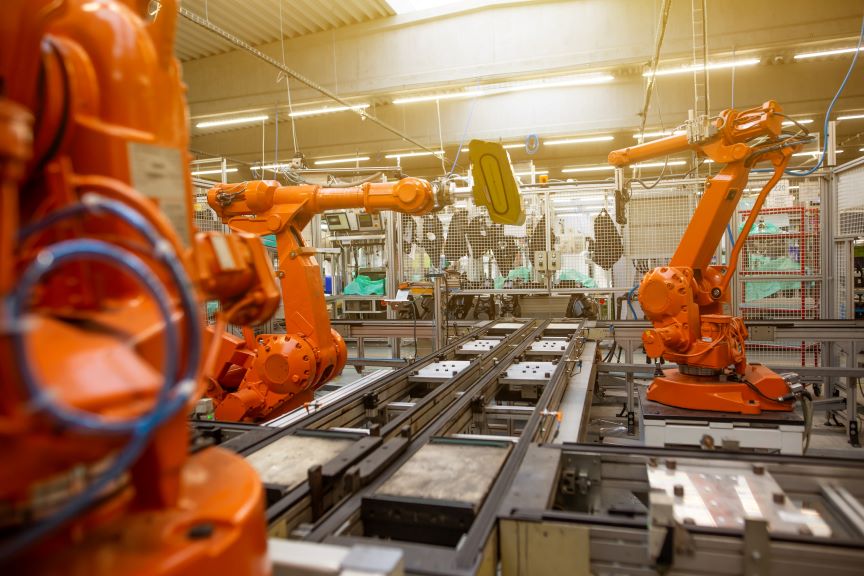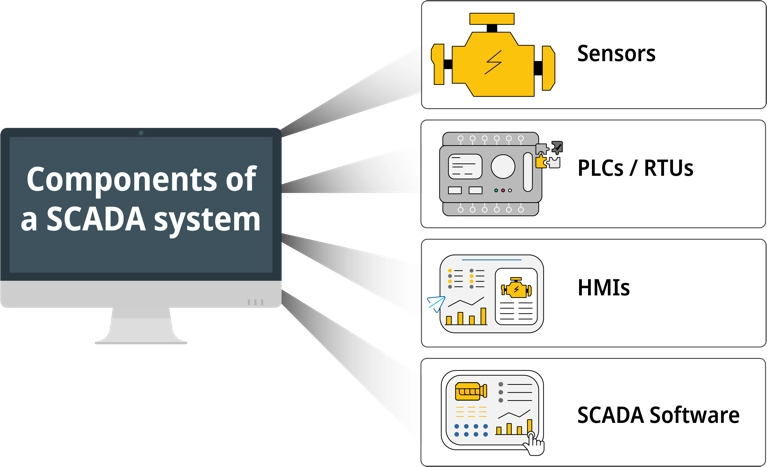
What is SCADA?
SCADA, an acronym for Supervisory Control and Data Acquisition, refers to a sophisticated system designed to monitor, control, and gather data from industrial operations. It integrates software and hardware components, facilitating real-time analysis and remote management of industrial devices, ensuring efficiency and reliability in various sectors. This comprehensive system supports decision-making by providing actionable insights into industrial processes.
What is a SCADA System?
A SCADA system is a network of hardware and software for the real-time monitoring, supervision, and control of industrial machines and facilities. SCADA stands for Supervisory Control and Data Acquisition.
Industrial plants rely on SCADA systems to manage operations, quickly alert them of machine faults, and help maximize production efficiency.
SCADA systems are composed of three major components:
- Sensors, which capture production monitoring data that may range from temperature to flow rate and pressure.
- Programmable Logic Controller (PLC) and Remote Terminal Unit (RTU) microcomputers that aggregate data from sensors and other devices.
- And Human-Machine Interfaces (HMIs), which display the data and allow operators to control key functionalities.
Giving operators deep insight into machine performance and the power to visualize and manage production lines, SCADA systems are invaluable control centers for industrial automation.
Maintenance and reliability teams can use a CMMS for SCADA integration, which gives maintenance access to SCADA data. Together, a CMMS and SCADA system help maintenance teams revolutionize their maintenance strategy with condition-based maintenance.
How Does SCADA Work?
A SCADA system works by sensors taking measurements, which PLCs and RTUs gather and send to an HMI for a SCADA operator to view, analyze, and act on. SCADA software brings all three elements together, taking the data and generating a visualization and command center on an HMI.
SCADA systems have four major purposes:
- Acquiring data
- Data sharing & communication
- Data visualization & mapping
- Control functionalities
Components of a SCADA System
Here’s more information how each component of the average SCADA network works.

- Sensors: SCADA sensors are often wired into key and production-critical machine assets that require monitoring. SCADA systems gather data from sensors that capture temperature readings, water flow, pipe pressure, current, humidity, gas, and a variety of other measurements. Motors, valves, pumps, and air compressors are common assets that might have wired sensors that connect to SCADA.
- PLCs / RTUs: A PLC is an industrial microcomputer for receiving data from input devices like sensors. Beyond simply aggregating sensor data, PLCs can also calculate equipment run time or usage, uptime and downtime, and generate alarms. Advanced PLCs can send data through a web browser, connect to SQL databases, and even interface with the cloud. RTUs are also data-aggregating microcomputers, but with a few key differences: they are commonly pre-programmed, wireless, extremely durable, and ideal for capturing data from remote assets / remote areas.
- HMIs: An HMI generates a visualization of the SCADA data, ranging from simple displays to large, interactive touchscreens. HMI displays will generally show maps of the facility’s production lines, with icons representing individual measurement points and/or assets. They also often feature data charts, reports, or dashboards.
- SCADA Software: SCADA software assembles the data relayed by PLCs and RTUs and translates it into production maps and data visualizations for operators. Smaller SCADA systems may have software localized to a single HMI / PC, while larger SCADA networks may have a master station with a software that connects to multiple HMIs and servers.
Sophisticated software like Ignition goes beyond the fundamentals of processing data and providing visualizations, serving as a SCADA platform. SCADA platforms are often web-based and give users the ability to develop their own SCADA setup, set conditional alarms, and design performance reports.
A versatile SCADA platform may connect to both sensors and IIoT devices, a wide range of PLCs, SQL data bases, MES/MOM systems, ERPs, and even other SCADA systems.
SCADA software is one of many CMMS integrations used by maintenance and reliability.
What’s the Difference Between SCADA and PLC?
The difference between PLC and SCADA is that a PLC is a hardware, data-acquisition component of a SCADA system.
PLCs are microcomputers designed to gather industrial data from inputs like sensors and communicate the data to a command center, whereas a SCADA system serves as that command center.
A SCADA system encompasses sensors, multiple PLCs/RTUs, HMIs, SCADA software, servers, and more, working together to give operators real-time monitoring and control.
SCADA Integration: How Does a CMMS Integrate with SCADA?
Maintenance and reliability teams can use a Computerized Maintenance Management System (CMMS) to tap into SCADA systems, unlocking a wealth of data and enabling condition-based maintenance.
Production monitoring data is often siloed. Operations teams can access real-time asset data with SCADA systems, but maintenance teams don’t usually have a comprehensive data acquisition tool at their fingertips.
A CMMS like eMaint solves this problem: eMaint integrates with SCADA, BMS/BAS, MES/MOM, PLCs, and more industrial systems and software. Once connected, eMaint CMMS will record SCADA measurements as directed by the user. Users can specify which types of measurements to capture from which assets, what time of day the measurements occur, and how often data is siphoned from the SCADA system.
eMaint also empowers maintenance and reliability teams to achieve condition-based maintenance with their CMMS and SCADA integration. Condition-based maintenance is the strategy of performing maintenance based on usage and condition data, like hours run or temperature.
- Reactive maintenance is performed spontaneously in response to failures, meaning it’s too late to prevent them.
- Preventive maintenance helps prevent faults and failures, but it’s based on arbitrary time schedules—this means that you run the risk of under-maintenance, which leads to faults, or over-maintenance, which wastes time, money, and labor.
- Condition-based maintenance, or CBM, is performed on the right asset and the right time. CBM is optimized thanks to asset data.
That’s where eMaint comes in: eMaint’s SCADA integration brings in asset data from your SCADA system and allows you to set alarms, which can be sent to eMaint to trigger condition-based work orders.
eMaint lets you set up condition-based work orders to trigger automatically when condition data goes past your set limits. A motor, for example, may exceed normal temperatures. This triggers an alarm, which in turn causes eMaint to generate a work order. Maintenance work is performed right in time to prevent problems and enhance lifespan.
Connecting your CMMS to your SCADA system equips maintenance and reliability teams with invaluable data and tools that can make the difference when it comes to maximizing uptime, strengthening reliability, and driving production.
